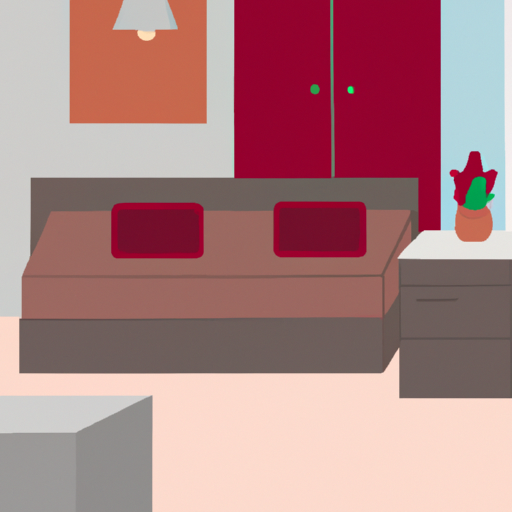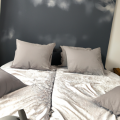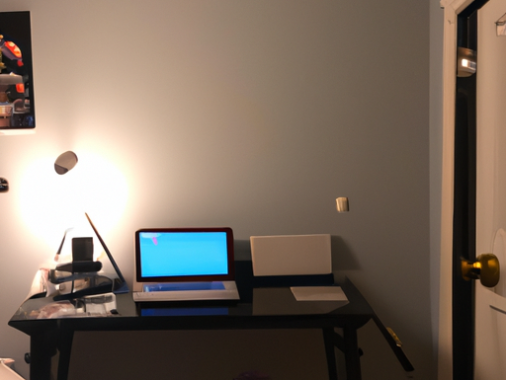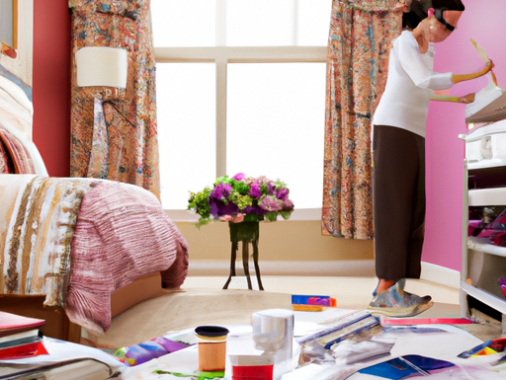-
Table of Contents
- Introduction
- How to Choose the Right Color Palette for Your Room Design
- 10 Tips for Creating a Cozy and Inviting Room Design
- How to Incorporate Feng Shui Principles into Your Room Design
- How to Maximize Space in a Small Room Design
- How to Incorporate Natural Elements into Your Room Design
- How to Choose the Right Furniture for Your Room Design
- How to Incorporate Lighting into Your Room Design for Maximum Effect
- Q&A
- Conclusion
Introduction
Designing your own room can be a fun and creative way to express yourself and make your space feel like home. Whether you’re starting from scratch or just looking to spruce up your existing decor, there are plenty of ideas to help you create the perfect room. From choosing the right colors and furniture to adding the perfect finishing touches, this guide will help you create a room that’s both stylish and functional.
How to Choose the Right Color Palette for Your Room Design
When it comes to designing a room, the color palette you choose is one of the most important decisions you will make. The colors you select will set the tone for the entire space and will influence the overall look and feel of the room. To ensure that you make the right choice, it is important to consider the following factors when selecting a color palette for your room design.
First, consider the purpose of the room. Different colors can evoke different emotions and create different atmospheres. For example, bright colors can create a cheerful and energetic atmosphere, while muted colors can create a more calming and relaxing atmosphere. Think about how you want people to feel when they enter the room and choose colors that will help create that atmosphere.
Second, consider the size of the room. Larger rooms can handle bolder colors, while smaller rooms may be better suited to more subtle colors. Additionally, lighter colors can make a room appear larger, while darker colors can make a room appear smaller.
Third, consider the existing furniture and decor in the room. If you have existing furniture and decor, you will want to choose a color palette that complements them. Consider the colors of the furniture and decor and choose colors that will work well with them.
Finally, consider the lighting in the room. Natural light can make colors appear brighter and more vibrant, while artificial light can make colors appear duller and more muted. Consider the type of lighting in the room and choose colors that will look best in that type of lighting.
By considering these factors, you can ensure that you choose the right color palette for your room design. With the right colors, you can create a space that is both beautiful and functional.
10 Tips for Creating a Cozy and Inviting Room Design
1. Choose a Color Palette: Selecting a color palette is the first step in creating a cozy and inviting room design. Consider colors that evoke feelings of warmth and comfort, such as earth tones, pastels, and muted shades.
2. Add Texture: Incorporating texture into your room design is essential for creating a cozy atmosphere. Consider adding plush rugs, soft throws, and cozy pillows to add visual interest and texture.
3. Incorporate Natural Elements: Incorporating natural elements into your room design can help to create a cozy and inviting atmosphere. Consider adding plants, wood accents, and natural fibers to your room design.
4. Use Lighting to Create Ambiance: Lighting can be used to create a cozy and inviting atmosphere. Consider adding dimmable lighting, such as table lamps and floor lamps, to create a warm and inviting atmosphere.
5. Add a Fireplace: Adding a fireplace to your room design can help to create a cozy and inviting atmosphere. Consider adding a gas or electric fireplace to your room design for a warm and inviting atmosphere.
6. Incorporate Cozy Furniture: Incorporating cozy furniture into your room design is essential for creating a cozy and inviting atmosphere. Consider adding oversized chairs, plush sofas, and comfortable ottomans to your room design.
7. Hang Artwork: Hanging artwork in your room design can help to create a cozy and inviting atmosphere. Consider adding artwork that evokes feelings of warmth and comfort, such as landscapes and abstract pieces.
8. Add Mirrors: Adding mirrors to your room design can help to create a cozy and inviting atmosphere. Consider adding mirrors to reflect light and create the illusion of more space.
9. Incorporate Soft Fabrics: Incorporating soft fabrics into your room design is essential for creating a cozy and inviting atmosphere. Consider adding curtains, throws, and pillows made from soft fabrics, such as velvet and chenille.
10. Add Accent Pieces: Adding accent pieces to your room design can help to create a cozy and inviting atmosphere. Consider adding candles, books, and decorative objects to your room design for a cozy and inviting atmosphere.
How to Incorporate Feng Shui Principles into Your Room Design
Feng shui is an ancient Chinese practice that seeks to create balance and harmony in the home. It is based on the idea that energy, or “chi,” flows through the home and can be manipulated to create a more positive environment. Incorporating feng shui principles into your room design can help create a more peaceful and inviting space.
The first step in incorporating feng shui principles into your room design is to assess the flow of energy in the space. Pay attention to the placement of furniture and the direction of the door. The goal is to create a smooth flow of energy throughout the room. Avoid placing furniture in a way that blocks the flow of energy, such as placing a bed directly in front of the door.
The next step is to consider the colors and materials used in the room. Colors can have a powerful effect on the energy of a space. Choose colors that are calming and soothing, such as blues and greens. Avoid bright colors, such as reds and yellows, which can be too stimulating. Materials should also be chosen carefully. Natural materials, such as wood and stone, are best for creating a peaceful atmosphere.
The placement of objects in the room is also important. Objects should be placed in a way that encourages positive energy. For example, plants can be used to bring in positive energy and create a sense of balance. Mirrors can also be used to reflect positive energy and create a sense of openness.
Finally, it is important to consider the lighting in the room. Natural light is best for creating a peaceful atmosphere. If natural light is not available, use soft lighting to create a calming atmosphere.
By following these simple steps, you can incorporate feng shui principles into your room design and create a more peaceful and inviting space.
How to Maximize Space in a Small Room Design
Maximizing space in a small room can be a challenge, but with the right design strategies, it is possible to create a functional and aesthetically pleasing space. Here are some tips to help you make the most of a small room:
1. Utilize vertical space: Make use of the walls and ceiling by adding shelves, hanging storage, and other wall-mounted items. This will help to free up floor space and create more storage.
2. Choose furniture wisely: Choose furniture that is multi-functional and can be used for multiple purposes. For example, an ottoman can be used as a coffee table, extra seating, and storage.
3. Use light colors: Light colors will help to make the room appear larger and brighter. Choose light colors for the walls, furniture, and accessories.
4. Add mirrors: Mirrors can help to create the illusion of more space by reflecting light and making the room appear larger.
5. Use rugs: Rugs can help to define the space and make it feel larger. Choose a rug that is the same color as the walls to create a seamless look.
By following these tips, you can create a functional and aesthetically pleasing space in a small room. With the right design strategies, you can maximize the space and make the most of your small room.
How to Incorporate Natural Elements into Your Room Design
When it comes to interior design, incorporating natural elements into a room can be a great way to create a calming and inviting atmosphere. Natural elements can be used to add texture, color, and warmth to a room, and can be used to create a unique and inviting space. Here are some tips for incorporating natural elements into your room design.
1. Use Natural Materials: Incorporating natural materials into your room design is a great way to bring the outdoors in. Consider using natural materials such as wood, stone, and bamboo for flooring, furniture, and accents. Natural materials can add texture and warmth to a room, and can be used to create a cozy and inviting atmosphere.
2. Add Plants: Adding plants to your room design is a great way to bring a bit of nature into your home. Plants can be used to add color and texture to a room, and can also help to purify the air. Consider adding a few potted plants to your room design to create a natural and inviting atmosphere.
3. Incorporate Natural Light: Natural light is a great way to bring the outdoors into your home. Consider adding large windows or skylights to your room design to allow natural light to flood the space. Natural light can help to create a bright and airy atmosphere, and can also help to reduce energy costs.
4. Use Natural Colors: Incorporating natural colors into your room design is a great way to create a calming and inviting atmosphere. Consider using colors such as greens, blues, and browns to create a natural and inviting space. Natural colors can help to create a soothing and calming atmosphere, and can also help to create a sense of balance and harmony.
By incorporating natural elements into your room design, you can create a unique and inviting atmosphere. Natural elements can be used to add texture, color, and warmth to a room, and can help to create a calming and inviting atmosphere. Consider using natural materials, adding plants, incorporating natural light, and using natural colors to create a unique and inviting space.
How to Choose the Right Furniture for Your Room Design
When it comes to designing a room, furniture is an essential element. Choosing the right furniture for your room design can be a daunting task, but it doesn’t have to be. With a few simple tips, you can select the perfect pieces to create a beautiful and functional space.
First, consider the size of the room. Measure the dimensions of the room and make sure to take into account any existing furniture or fixtures. This will help you determine the size and number of pieces that will fit comfortably in the space.
Next, think about the purpose of the room. Are you looking for a cozy living room, a functional office, or a stylish bedroom? Knowing the purpose of the room will help you decide which pieces of furniture to choose.
Once you’ve determined the size and purpose of the room, it’s time to select the furniture. Consider the style of the room and choose pieces that complement the overall design. Look for pieces that are both functional and aesthetically pleasing.
Finally, think about the materials used in the furniture. Choose pieces that are made from durable materials that will last for years to come. Consider the color and texture of the furniture to ensure it fits with the overall design of the room.
By following these simple tips, you can easily choose the right furniture for your room design. With the right pieces, you can create a beautiful and functional space that you’ll love for years to come.
How to Incorporate Lighting into Your Room Design for Maximum Effect
Lighting is an essential element of any room design, as it can create a certain atmosphere and set the mood for the entire space. When used correctly, lighting can be used to highlight certain features of a room, create a sense of depth, and even make a room appear larger. Here are some tips for incorporating lighting into your room design for maximum effect.
First, consider the purpose of the room. Different types of lighting can be used to create different atmospheres. For example, task lighting is best for areas where you need to focus on a specific task, such as a home office or a kitchen. Accent lighting can be used to highlight certain features of a room, such as artwork or architectural details. Ambient lighting is best for creating a general atmosphere in a room, such as a living room or bedroom.
Second, think about the type of lighting you want to use. There are many different types of lighting, such as natural lighting, incandescent lighting, fluorescent lighting, and LED lighting. Each type of lighting has its own advantages and disadvantages, so it’s important to consider which type of lighting will best suit your needs.
Third, consider the placement of the lighting. The placement of the lighting can have a big impact on the overall effect of the room. For example, if you want to create a cozy atmosphere, you may want to place the lighting in the corners of the room. If you want to create a more dramatic effect, you may want to place the lighting in the center of the room.
Finally, think about the color of the lighting. Different colors of lighting can create different effects. For example, warm colors such as yellow and orange can create a cozy atmosphere, while cool colors such as blue and green can create a more modern feel.
By following these tips, you can incorporate lighting into your room design for maximum effect. With the right lighting, you can create a unique atmosphere and set the mood for the entire space.
Q&A
1. What are some tips for designing my room?
A. Start by considering the size and shape of the room, the existing furniture, and the colors and textures you want to use. Think about how you want to use the space and what kind of atmosphere you want to create. Consider the lighting, storage, and furniture placement. Finally, accessorize with artwork, plants, and other decorative items.
2. How can I make my room look bigger?
A. Use light colors on the walls and floors to create an airy feel. Hang mirrors to reflect light and make the room appear larger. Choose furniture with slim silhouettes and keep the clutter to a minimum.
3. What are some ideas for decorating my room?
A. Hang artwork, add plants, and use rugs and throws to add texture and color. Incorporate interesting lighting fixtures and use wall decals to create a unique look. Consider adding a statement piece of furniture or a unique accent wall.
4. How can I make my room more comfortable?
A. Choose comfortable furniture and add plenty of pillows and throws. Hang curtains to block out light and noise. Add a cozy rug and use warm lighting to create a relaxing atmosphere.
5. What are some ideas for organizing my room?
A. Use shelves, baskets, and bins to store items. Hang hooks for coats and bags. Use drawer dividers and stackable boxes to keep items organized. Consider adding a desk or dresser with plenty of drawers.
6. How can I make my room look stylish?
A. Choose a color palette and stick to it. Incorporate interesting textures and patterns. Hang artwork and add decorative accents. Consider adding a statement piece of furniture or a unique accent wall.
7. What are some tips for creating a budget-friendly room design?
A. Shop around for furniture and accessories. Look for second-hand items or DIY projects. Use paint and wallpaper to create a new look. Incorporate plants and artwork to add color and texture. Consider using removable wall decals or wallpapers for a temporary look.
Conclusion
Designing your room can be a fun and creative process. It is important to consider the size and shape of the room, the colors and textures you want to use, and the furniture and accessories that will make the room feel comfortable and inviting. With a little bit of planning and creativity, you can create a room that is both stylish and functional.




